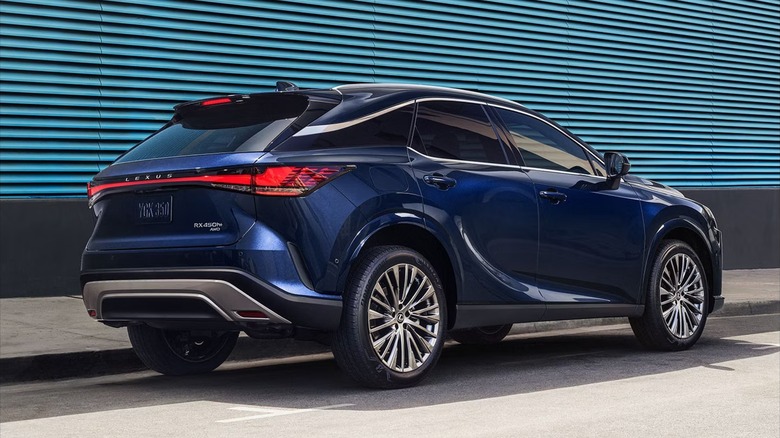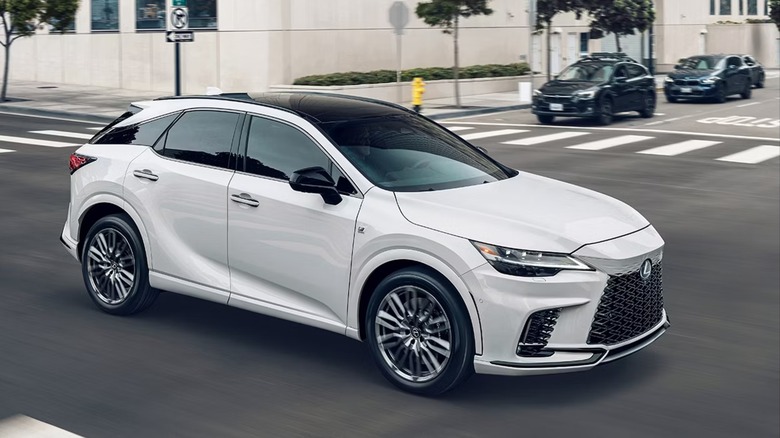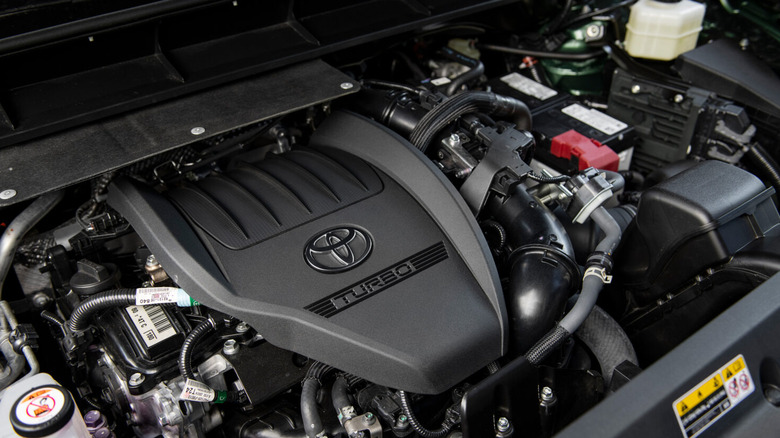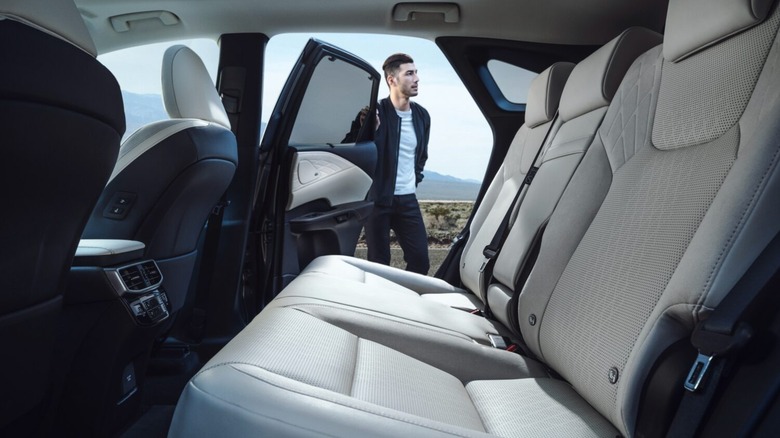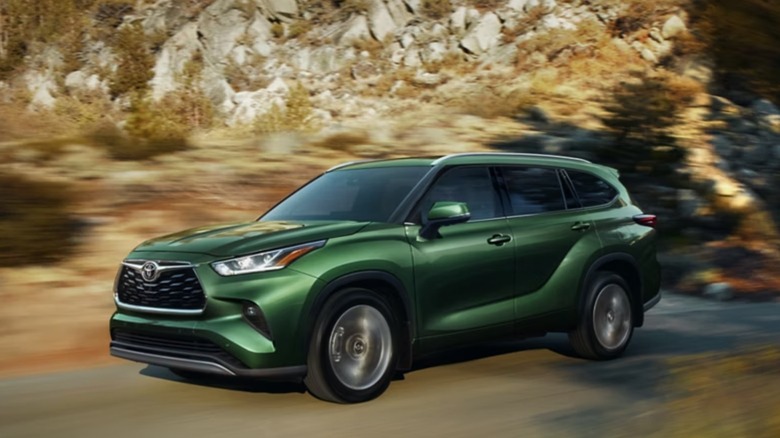How Does The Lexus RX 350 Compare To The Toyota Highlander Platinum?
Comparing a loaded Toyota Highlander to a well-equipped Lexus RX 350 might sound like an apples-to-oranges matchup. But if you're hunting for a family-friendly SUV with a rock-solid reputation for reliability, it's a comparison you'll want to make. Both models earn praise from Consumer Reports and rack up high scores from J.D. Power. When you get down to it, the big question is: Do you go for a top-tier Highlander with all the bells and whistles, or spend about the same on a base RX? There are things you should know before plunking down cash on a Toyota Highlander or splurging for a Lexus RX 350.
Truth is, the right answer depends on what matters most to you because everyone has different priorities. Still, we'll break down how these two heavy-hitters stack up. We'll mainly focus on the range-topping Toyota Highlander Platinum and the entry-level Lexus RX 350 — both from the 2025 model year — but we'll also dive into pricing and the different powertrain options if you're eyeing a higher-end RX (which means Radiant Crossover, if you're curious what RX stands for).
What does your budget get you?
A recent study by AutoInsurance.com reports that most car buyers cite price as the most important factor in making a purchasing decision. So, it only makes sense to dive into the numbers with this Highlander versus RX contest. A Highlander Platinum comes with a $52,225 price tag before destination charges; all-wheel drive (AWD) is standard on this trim, with this feature being optional on lower trims. The Highlander Hybrid Platinum, on the other hand, costs $53,975.
The RX 350's starting price is $50,475, but that's for one with front-wheel drive (FWD). Adding AWD changes the window sticker to $52,075, only $150 less than the loaded Highlander. Move up the RX 350's food chain to higher-level trims, and the prices approach $60,000. Buyers considering the hybrid RX 350h (with standard AWD) will find it starts at $52,775, undercutting the Toyota by $1,200.
There's also an RX plug-in hybrid — the RX 450h+ — that sells for $72,610, and a performance-oriented hybrid variant — the RX 500h — that costs $66,150. Neither model has an equivalent in the Highlander lineup.
Highlander and RX powertrain options
V6 power left the Toyota Highlander's engine bay with the debut of the 2023 model year, coinciding with the launch of the fifth-generation Lexus RX and its lack of six cylinders. Both models rely on different forms of four-cylinder power. The Highlander Platinum's powerplant options are straightforward. The standard engine is a turbocharged 2.4-liter inline-four making 265 horsepower. It's connected to an eight-speed automatic transmission and is EPA-rated at 24 mpg combined. The Highlander Hybrid uses a naturally aspirated 2.5-liter four-cylinder engine paired with a hybrid system that delivers 243 net horsepower.
In typical Toyota fashion, the gearbox is an electronically controlled continuously variable transmission (eCVT). These Highlanders have a combined fuel economy rating of 35 mpg. The RX offers numerous engine choices. The RX 350 shares the Highlander's 2.4-liter base engine and transmission but gains an additional 10 horsepower while still delivering 24 mpg combined. Similarly, the RX 350h piggybacks on the Highlander Hybrid's 2.5-liter unit but ekes out three additional ponies and one extra combined mpg. Output increases significantly with higher RX variants.
The 2.5-liter hybrid gets the plug-in treatment in the 450h+, which is good enough for 304 combined horsepower, 37 miles of all-electric driving, and 36 combined mpg. The 500h adds turbocharging and hybrid technology to the 2.4-liter four-cylinder, yielding 366 horsepower and 27 combined mpg. Yet this most powerful RX uses a six-speed automatic instead of the eCVT in the other RX hybrids. All RX information here reflects AWD.
Highlander and RX 350 interiors
If three rows of seating are mandatory, the Highlander is the clear winner. The last three-row RX 350 (the RX L) saw a Lexus showroom in 2022, the final year of the fourth generation. The latest RX is exclusively a five-passenger crossover (three-row duties are assigned to the Lexus TX, which fixed what the RX L got wrong, as well as the GX and LX). While the Highlander Platinum has three rows, it's worth mentioning that the second row comprises a pair of captain's chairs, giving this Toyota a seven-passenger capacity. The RX (or a lower Highlander trim) gets the nod if a three-person bench seat is preferred.
From a luxury and comfort standpoint, the Highlander Platinum maxes out with leather upholstery, heated and ventilated front seats, and heated second-row seats. Other standard niceties are a heated steering wheel, tri-zone automatic climate control, a surround-view monitor, and a panoramic glass top with a front power moonroof. The RX 350 has NuLuxe upholstery (leatherette in Lexus-speak), heated front seats, and dual-zone climate control. You'll need to spend more for options or a higher RX trim to equal most of the Highlander Platinum's equipment roster.
Both models are aligned in the infotainment department, offering a 12.3-inch touchscreen, wireless smartphone integration (Apple CarPlay and Android Auto), Wi-Fi hotspot capability, and access to cloud-based navigation and other connected services. Wireless device charging is standard with the top-dog Highlander and optional on the base RX 350.
Dimensions and capacities
The Toyota Highlander and Lexus RX share common DNA. Both models are built on Toyota's TNGA-K platform (Toyota New Global Architecture, K variant), which also underpins the larger Toyota Grand Highlander and Lexus TX crossovers. As a result, there isn't much difference in exterior dimensions. Both vehicles have the same 112.2-inch wheelbase, with the Highlander Platinum stretching out to an overall length of 194.9 inches. Meanwhile, the RX 350 measures 192.5 inches from bumper to bumper. The 2.4-inch gap could make a difference in a tight garage space. The separation in width is negligible: 76.0 inches for the Highlander and 75.6 for the RX.
However, the separation is more significant inside. Despite having three rows, the Highlander's 42 inches of front legroom outstretches the 41.1 inches offered by the RX. The same applies in the second row, with the Highlander providing 38.7 inches of legroom against 38.0 inches for the RX. For the record, the Highlander's third row has 28 inches of legroom.
The Highlander's 16 cubic feet of cargo space falls short of what's available behind the RX's second row: 29.6 cubic feet. However, if the Highlander's third row is flipped down, the cargo capacity grows to 48.4 cubic feet. Behind the first row (with all rear seats folded), the Highlander remains the hauling champion with 84.3 cubic feet of available space versus 46.1 cubic feet for the RX.
